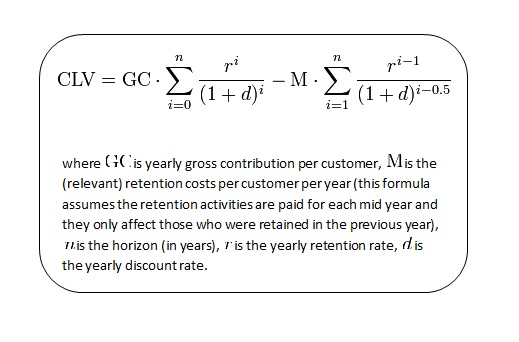Apps today are a dime a dozen. Some accomplish success, while others experience a setback. This brings us to the app dissection table with a fair amount of banter that surrounds mobile app marketing metrics.
App marketing arena is often a buzz around the metrics that matter and the one’s that are often overlooked, especially when only 26% of apps are opened only once! All these metrics influence the shelf life of an app.
Customer Lifetime Value or CLTV is one metric that has always grabbed the attention of critics and app developers alike. In form of a pure definition, it means:
The sum total of all the revenue generated by a user from the point of app installation until it is no longer used.
Micah Gantman, Vice President of Business Development and Strategy at Tune has explained the correlation in an apt manner. He says:
“Acquiring users with LTVs greater than the cost per install (CPI) is not only a strong indicator of effective mobile marketing, it is essential to the long-term success of an app.”
But that’s not all. A thorough knowledge of CLTV can help app developers in not only gauging app loyalty but also in fine-tuning their marketing efforts. CLTV also helps developers in putting marketing dollars to good use and understanding the worth of each app user, amongst others.
In this article, we aim at exploring this metric from close corners. It is rather essential to know why and how it can affect an app’s growth.
What Constitutes Customer Lifetime Value?
Now that we have a brief idea about customer lifetime value, it is critical to understand its constitution. Lloyd Melnick has broken this metric into three parts, each with a unique purpose. Lloyd is the Director of Social Gaming at Rational Group and the man behind Zynga’s social casino apps.
In his benchmark post on Customer lifetime value, Lloyd explains this further.
-
Monetization– The amount spent by an app user in its lifetime and includes micro metrics like ARPDAU (average revenue per daily active user), ARPPU (average revenue per paying user) and ARPU (average revenue per user).
-
Retention– retention stands for the level of engagement that a user has with your app, within a certain period.
-
Virality– a measure of the total number of new users brought in by the existing users.
For an E-commerce app, it may mean In-app purchases and for a music app it may mean total time spent on the app. For some apps, it may also indicate the amount of referrals that came their way.
How To Calculate Customer Lifetime Value For An App?
Customer Lifetime Value can be calculated by measuring monetization, retention, and virality, as mentioned above. Alex Walz– Marketing at Apptentive has explained it in the simplest manner possible. I’ve listed it below, considering that sometimes one should not challenge perfection!
Measuring The Lifetime Value Of A Mobile Customer
Tapdaq has provided a more workable example to understand this concept.
I would also recommend an approach that talks about calculating Receipt LTV, Weekly Cohort LTV, Multiplier LTV, Average LTV and Weighted LTV, meant especially for game- app developers, but can be applied to other apps as well.
Why Should An App Developer Bother About Customer Lifetime Value?
Precisely for the value it will add to your overall app marketing initiatives. But for the sake of debate we are listing a few examples that will help you with a much clearer picture of the metric along with a few practical examples.
Moderating The App Marketing Expenses
The cost of acquisition is painstakingly high. A clear understanding of CLTV can help app developers in reducing the expenses while acquiring a new customer. An app developer may increase spends on In-app ads or stop it for that matter, depending on the post- install data.
Evaluate The Acceptance Of New In-App Features
With the CLTV data in place app, developers can evaluate the acceptance of new In-app features and how app users are adapting to it.
Nailing The Best Marketing Strategy For App Growth
Customer Lifetime Value is also a valid indicator of the channel that can attract users and the one that can’t. Instead of guesswork, it gives app developers the ability to nail its most profitable tactic. For example, whether it was In-app referrals or a paid social media campaign that made them download an app. This also gives them the power to shun tactics that are not financially viable.
Identifying The Right Customer For The App
It also helps in segmenting an app’s high-value user from its low-value users. For example, a travel app may identify the users that are more likely to make an in-app purchase as opposed to the ones that only browse its content.
Making The Most From App Loyalists
Every app has a percentage of users that can be termed loyalists. These are the users that refer your apps incessantly, thereby increasing app downloads. CLTV helps app developers in identifying and separating these loyalists from the crowd.
Predict Future Profits For The App
There’ a lot of debate around “total revenue” being the right measure of an app’s profitability. An article that discusses the benefit of CLTV for game app developers throws light on this example. The article mentions that:
“Although one might argue that increasing total revenue is the ultimate goal and hence what is described here is a success story, such growth is not *sustainable*. If the revenue per user keeps decreasing, then the game will likely cease generating any profits in the near future. Especially freemium games often fool their developers in just this way.
The reason to calculate the LTV of your existing players is to predict the net profit one can expect from the entire future relationship with a new player.”
Handy Platforms To Measure Customer Lifetime Value
Measuring customer lifetime value for app developers shouldn’t be difficult. Platforms such as Localytics and InMobi have eased out this issue for app developers.
The Last Word!
With numerous benefits and a simplistic approach, I believe measuring Customer Lifetime Value remains a critical exercise for developers. Once this metric is defined for your app you can take better decisions that surround your app’s marketing, product, sales and customer support.
Like always, please drop in your comments. If you’ve loved what you’ve just read, then don’t hesitate to share it!


